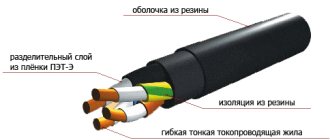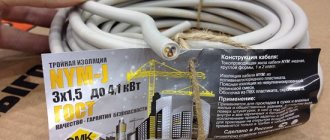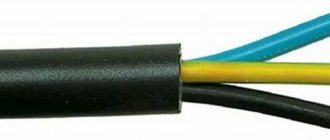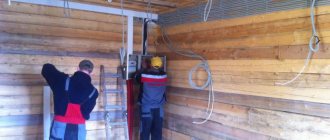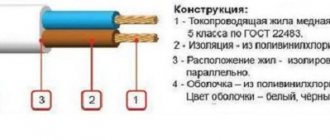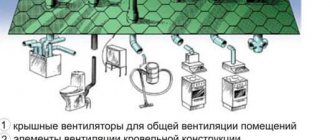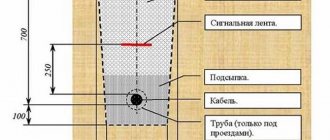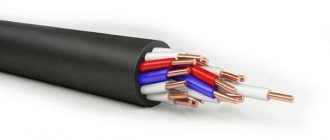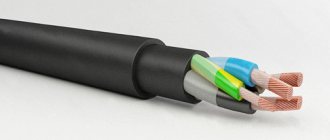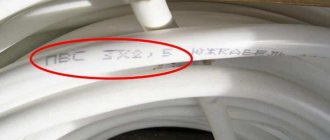The development of electrical networks and a significant increase in the number of consumers leads to numerous connections. Which is not possible to do with ordinary bare wires due to the danger of jamming and other factors. Therefore, the classic lines made with bare wire were replaced by SIP wire, which managed to occupy a niche for both household and industrial consumers. Such popularity of SIP was made possible due to a number of advantages in comparison with other brands.
Explanation of SIP markings
In comparison with other brands, SIP wire is a current-carrying element for transmitting electricity, which is deciphered by the three letters of the name:
- C – means that the wire is self-supporting;
- And - indicates the presence of insulation around current-carrying conductors;
- P - indicates that this is a wire, despite the presence of an insulating coating and branching along the cores, which is why it can be equated to a cable.
Consider an example of such a designation - SIP-1-3×20+1×25-0.4, here SIP-1 indicates the brand, 3×20 indicates that three insulated cores have a cross-section of 20 mm 2 each, 1×25 means that the neutral core has a cross-section of 25 mm 2, 0.4 is the rated voltage for this model.
Depending on the specific brand, there are five main types of SIP wire, designated by the corresponding numbers after the letter designation. There may be one letter at the end, indicating design differences and operational features. These differences in SIP brands are determined by design parameters, so it would be more appropriate to consider them using specific examples.
General information about SIP cable
SIP was developed by Finnish engineers in the 60s. XX century as a replacement for outdated non-insulated cables that were terminated on cables. Improved installation characteristics reduce the risk of jamming, short circuits and fire.
Explanation of markings
SIP is an abbreviation that is used to refer to self-supporting insulated wire. This product has complex markings, including alphabetic and numeric parts indicating key characteristics. If the package says “SIP-1-3x20+1x25-0.4”, the decoding will be as follows:
- SIP – self-supporting insulated wire;
- 1 – brand;
- 3x20 – 3 insulated conductors with a cross section of 20 mm²;
- 1x25 – neutral core with a cross-section of 25 mm²;
- 0.4 – nominal voltage for the model.
Areas of use
SIP is designed for laying overhead power lines. It can be mounted both on supports and on building facades. Often the cable is used to connect private homes to the network.
Design
Structurally, all types of SIP wires contain cores made in a certain shape with a given number, one of which can serve as a carrier string for the line.
They differ in type as follows:
- SIP-1 is a four-core wire in which each of the cores is represented by conductors twisted relative to each other. In this brand of SIP, three of them are designed for three phases and are equipped with thermoplastic insulation, and the fourth is for the neutral terminal, but it is not insulated. In a neutral conductor, the central wire is made of steel and acts as a load-bearing wire. If there is a letter A (SIP-1A) at the end of the marking, the zero terminal will be equipped with insulation.
Rice. 1: SIP-1 wire design - SIP-2 is the same four-wire version as the previous one, with the only difference being that the neutral wire is insulated. In the classic version, the neutral core is insulated with thermoplastic polyethylene, and in the SIP-2A brand, with cross-linked polyethylene, just like the phase ones. The second option is used for areas with significant exposure to atmospheric factors. Like the previous brand, this SIP is used in lines up to 1 kV.
Rice. 2: SIP-2 wire design - SIP-3 - unlike previous brands, is a single-core version of the current-carrying wire. Structurally, in the center of this SIP there is a steel supporting wire, which is surrounded by aluminum current-carrying conductors. It is used in high-voltage lines with a voltage of 6 - 35 kV for laying phases over long distances.
Rice. 3: SIP-3 wire design - SIP-4 is a pair system in which each core has its own pair, but, unlike the previous ones, it does not have a supporting element and a neutral wire. Therefore, this brand cannot be used for installing lines, since there is a possibility of it breaking when exposed to wind loads. Thermoplastic polyethylene is used as insulation here. There is a version of the brand with the letter N (SIP-4N), which indicates that the current-carrying elements are made of aluminum alloy; if the letter H is absent, the specific brand uses pure aluminum wire.
Rice. 4: SIP-4 wire design - SIP-5 - completely identical to the previous brand - also has a paired number of cores and does not contain a neutral wire with a supporting element. The only difference is the type of insulation covering the conductors; in the SIP-5 and SIP-5N brands it is cross-linked polyethylene, which allows you to increase the operating temperature limit by up to 30%.
Rice. 5: SIP-5 wire design
Specifications
The following table shows the main characteristics of the main types of cable.
| Characteristics | SIP-1 | SIP-2 | SIP-3 | SIP-4 | SIP-5 |
| Number of cores | 4 | 4 | 1 | 2-4 | 2-4 |
| Section | 16 ÷ 120 | 16 ÷ 120 | 35 ÷ 240 | 16 ÷ 120 | 16 ÷ 120 |
| Type of insulation (polyethylene) | thermoplastic | light stabilized | light stabilized | thermoplastic | light stabilized |
| Permissible heating | +70°C | +90°C | +70°C | +90°C | +90°C |
| Life time | 40 years | 40 years | 40 years | 40 years | 40 years |
Laying conditions
Due to the fact that laying SIP does not require any special skills, it can be done either at home or by the enterprise’s own resources without the involvement of a specialized organization. Laying can be carried out both on supports and on structural elements of buildings and structures. As a rule, fastening to walls is much easier than on a free-standing support.
Therefore, consider the conditions for installing SIP wire on reinforced concrete supports:
- Since the self-supporting insulating wire has an insulated sheath, it is important to provide a suspension that prevents damage to the dielectric layer. To do this, plastic rollers, grips and thimbles are installed, along which the wire can move freely.
- During the installation process, it is forbidden to drag the SIP along the ground or tree branches, as these can damage its insulation.
- To join different sections of SIP, sealed piercing-type clamps are used. Thanks to this design, it is possible to tap a line from an existing one even under voltage.
- Before fixing it on the support, the SIP wire must be pulled out through the moving element (for SIP brands from 1 to 3 using a dynamometer until the normalized load is set). After stretching, it is fixed at the fixation points.
All fasteners are factory-made, so they can be found complete with self-supporting insulating wire, which will greatly simplify the task.
Rice. 6: Example of fastening a SIP wire to a support
Application, advantages and disadvantages
Due to the presence of insulation, SIP has a fairly wide scope of application. It is most often used to introduce electricity into a building, and thanks to the outer layer of insulation, additional measures and devices are not required when passing through walls. Also, a self-supporting insulating wire can be used for local wiring of networks throughout the facility or when connecting subscribers to the lines of an energy supply organization. A separate area of application for SIPs are trunk lines that provide power supply to entire villages or distribution substations.
Compared to other brands of cable and wire products, SIP has a number of advantages, namely:
- SIP wire has significantly lower reactance compared to bare wires;
- Does not require the installation of additional insulators at points of attachment to supports, walls and when entering the building due to the presence of an insulating layer;
- Takes up less space due to the fact that the wires are collected together;
- Not subject to corrosive destruction due to the presence of a protective layer;
- Not afraid of overlap of adjacent phases under strong wind loads;
- Makes it difficult to illegally take power by throwing on wires;
The disadvantages of SIP wire include the greater weight of a linear meter, which is why the spans need to be reduced and supports installed more often. As well as the need to arrange additional insulation for certain categories of premises and consumers.
Main manufacturers
To avoid troubles when purchasing a wire or cable, you should pay attention not only to the main parameters of the product, but also to its manufacturer. Since low-quality models may have a smaller cross-section, low dielectric resistance to various types of influence, etc. If you have already purchased a self-supporting insulating wire and are not sure of its quality, check whether the cross-section corresponds to that stated in the passport. How to determine the cross section at home is described in the corresponding article - https://www.asutpp.ru/kak-opredelit-sechenie-provoda-ili-zhil-kabelya.html.
If you are just going to buy SIP, pay attention to the following manufacturers:
- Kama cable;
- Rybinskcable;
- GC "Sevkabel"
- Moscabel.
Using wires from the above-mentioned factories, you can be sure that they comply with the declared characteristics.
SIP is a type of wire for power and lighting power lines. The abbreviation stands for self-supporting insulated wire. These conductive products were developed by engineers of Finnish companies for radial power distribution schemes from 10/0.38 kV transformer substations in the 60s. Due to their advantages, such wires are gradually replacing conventional non-insulated conductive products. Self-supporting wires are used for both high-voltage and low-voltage lines.
Advantages and disadvantages
Advantages:
- Easy to install. It is much easier to install than conventional wires without insulation. They do not require fastening to insulators.
- Reducing electricity theft. Connecting to lines with such wires requires certain qualifications; it is quite difficult and not accessible to everyone.
- No icing. The material from which SIP insulation is made does not retain wet snow and condensation. Ice formation on overhead lines is very small.
- Reduce the risk of electric shock. Thanks to insulation, the likelihood of electric shock during repair and maintenance of the line is sharply reduced. Many jobs can be done under voltage.
- Reduced installation and operating costs. Due to their design, the wires are less prone to breaks. Maintaining power lines with wires of this type is much cheaper. Wires of this type can be attached to the facades of houses. This allows the use of fewer supports.
- Low inductance. Such lines have very low reactance. Voltage and power losses in lines using SIPs are significantly less. Low inductance avoids interference and makes it possible to attach low-voltage and control cables to line supports.
Read also: Angular gearbox for PTO on walk-behind tractor
Flaws:
- High price. Of course, such products are somewhat more expensive than bare wires, which are usually used for overhead lines.
- Lack of qualified specialists. Installation and maintenance of power transmission lines where these cables are used has its own characteristics. Such current-carrying products have appeared quite recently and have not yet become widespread. This is due to the lack of specialists who have the necessary skills and experience. In addition, domestic power supply systems are generally not suitable for a massive transition to current-carrying lines of self-supporting insulated wire.
Installation of SIP cable
According to GOST, the main areas of application of SIP cable are:
- installation of main power lines;
- installation of overhead lines and branches;
- organization of entrances to residential buildings and other buildings.
In addition, cables of this type can be laid openly directly along the facades of buildings, but they are not intended for laying intra-house cable routes.
Advantages of organizing cable lines using SIP
The main advantage of laying cable lines based on SIP cables, including the installation of SIP on supports, is the low material and labor costs for the work and subsequent maintenance of these lines.
During the operation of SIP cables, due to the presence of reliable and high-quality insulation, short circuits are practically eliminated due to negative natural influences (in particular, gusts of wind, freezing rain and snow sticking to the wires).
Among other things, this type of cable products has increased mechanical strength, minimizing the likelihood of their breakage.
Installation work associated with laying SIP cable lines is quite convenient and simple. The specialized fittings used in their process eliminate the need to install traverses and insulators on the overhead line support. This aspect greatly simplifies the process of installation and maintenance of SIP lines.
SIP laying
In addition, subject to strict compliance with all electrical safety rules, connection to a SIP line can be made without removing the voltage from the electrical installation.
Losses in power lines made of SIP cables are significantly lower than in lines made of conventional bare conductors. This is due to a threefold decrease in the reactance of an insulated conductor compared to a non-insulated one.
The service life of SIP cables is more than 25 years.
Piercing clamps for SIP cable
As mentioned above, during the installation of SIP conductors, specialized fittings are used, in particular, so-called punctures for SIP cables. They are intended for organizing branch lines and their use allows you to avoid the problematic cable termination to create branches.
In electrician slang, branch piercing clamps are also called nuts. They are one of the fundamental structural elements of overhead lines made of insulated conductors. The reliability of power supply to consumers connected to a given line directly depends on their quality and their installation.
The design of such a nut is based on a pair of contact plates combined with each other. Teeth are attached to them, through which the insulation of a self-supporting insulated wire is pierced, after which the teeth create reliable contact with the conductor cores.
In general, the puncture design is placed in a plastic case reinforced with fiberglass. This housing has a pair of recesses that accurately match the diameter of the SIP cable. Each of them contains contact plates. The above-mentioned puncture of insulation occurs under pressure on the clamp body of the bolted connection. Another function of this bolt is to secure the conductor inside the clamp.
Piercing clamp
Typically, so-called shear bolts, or bolts with a shear head, are used for these clamps. Externally, such fasteners are practically no different from ordinary hex head bolts, however, the connection formed by means of a shear bolt is practically permanent.
This feature is due to the fact that slightly below the hexagonal head the bolt has another, conical one, which is separated from the hexagonal head by a small jumper.
During the installation process, the shear bolt is screwed into the hole intended for it until the force of the wrench breaks off (that is, breaks off) the upper head of the bolt with six edges. Thus, only a smooth cone-shaped head will remain on the surface of the product, which is almost impossible to pry off with a key or other device.
The use of such bolts ensures that there is no pinching of the contacts inside the clamp, as well as damage to its body.
Important ! It is the use of piercing clamps for the installation of cable lines that makes it possible to connect additional branches and loads to them without the need to disconnect the line from the power source.
Since self-supporting insulated conductors are used for the installation of overhead power lines subject to a wide variety of environmental influences, an important property of piercing clamps is their complete tightness, for the creation of which, in addition to the structural features of the product body, special rubber caps that come with the clamps are designed. These caps are used to close the free ends of the cable coming out of the clamp.
Access to the house
Types of wire
By design, the following types of SIP cable are distinguished:
- SIP 1. Conductor products of this brand consist of aluminum phase conductors, insulated with ultraviolet-resistant polyethylene, and an uninsulated neutral wire. To increase strength (the neutral conductor also performs a load-bearing function), the neutral wire of this brand has a steel core. If the marking of such a cable has the letter A, then the neutral conductor has an insulated core. The scope of application of this brand of wire is low-voltage lines with voltages up to 1000 V.
- SIP 2. This wire or cable is used in power and lighting lines up to 1 kV. This wire consists of 4 cores made of aluminum in polyethylene insulation. The neutral conductor, which performs the load-bearing function, is reinforced with a steel core.
- SIP 3. Leading products of this brand consist of one steel-aluminum conductor insulated with polyethylene. These products are used for constructing high-voltage networks. The rated voltage of these wires is 10 kV... 35 kV.
- SIP 4. This wire consists of 2 or 4 insulated conductors. The difference between SIP 2 and SIP 4 lies in the design of the cores. SIP 4 does not have a load-bearing core. This wire is used in overhead lines up to 1000 V in power and lighting electrical networks.
- SIP 5. For overhead power transmission lines with voltages of 10, 15, 20 kV and 35 kV with a nominal frequency of 50 Hz in the air atmosphere, including on the coasts of seas, salt lakes, etc. The wire structure consists of aluminum conductors; there is no separate supporting conductor.
SIP types: SIP-1, SIP-2, SIP-3, SIP-4
Specifications
- Ambient temperature from -50°С to +50°С
- Relative air humidity at temperatures up to +35°C - 98%
- Maximum core heating temperature during short circuit +250°C
- Minimum wire laying temperature without preheating -20°C
- Maximum permissible operating temperature of the cores +90°С
- Maximum permissible heating temperature of cores in emergency mode or overload mode +130°C
- Minimum permissible bending radius when laying 7.5 wire diameters
- Permissible forces in the zero load-bearing core during tension and operation should not exceed 45 N/mm 2
- The insulated wire cores withstand an alternating voltage test of 3.5 kV with a frequency of 50 Hz per pass. Wires after exposure to water at a temperature of (20±10)°C
- The wires withstand an alternating voltage test of 4 kV with a frequency of 50 Hz for 1 hour
- Wires after exposure to water at a temperature of (20±10)°C for at least 10 minutes. withstand an alternating voltage test with a frequency of 50 Hz for 5 minutes, the value of which for wires of the SIP-1 and SIP-2 brands is 4 kV
- The wires are resistant to solar radiation, characterized by an upper integral heat flux density of 1120 W/m2 ±10%, including a density of the ultraviolet part of the spectrum of 68 W/m2 ±25%
| Cable brand | Number of cores and cross-section, mm 2 | Outer diameter, mm | Weight 1 km, kg | Availability and prices |
| SIP-1 | ||||
| 1x16 + 1x25 | 15,0 | 159,0 | price | |
| 3x16 + 1x25 | 22,0 | 294,48 | price | |
| 3x25 + 1x35 | 26,0 | 434,19 | price | |
| 3x35 + 1x50 | 30,0 | 600,04 | price | |
| 3x50 + 1x70 | 35,0 | 815,64 | price | |
| 3x70 + 1x95 | 41,0 | 1122,41 | price | |
| 3x95 + 1x70 | 43,0 | 1285,0 | price | |
| 3x95 + 1x95 | 44,0 | 1380,0 | price | |
| 3x120 + 1x95 | 47,0 | 1620,18 | price | |
| 4x16 +1x25 | 22,0 | 362,40 | price | |
| 4x25 + 1x35 | 26,0 | 535,39 | price | |
| SIP-2 | ||||
| 1x16 + 1x25 | 15,0 | 157,90 | price | |
| 3x16 + 1x25 | 22,0 | 290,40 | price | |
| 3x25 + 1x35 | 26,0 | 428,90 | price | |
| 3x35 + 1x50 | 30,0 | 574,61 | price | |
| 3x50 + 1x50 | 33,0 | 713,0 | price | |
| 3x50 + 1x70 | 35,0 | 809,51 | price | |
| 3x70 + 1x70 | 38,0 | 983,0 | price | |
| 3x70 + 1x95 | 41,0 | 1089,59 | price | |
| 3x95 + 1x70 | 43,0 | 1255,0 | price | |
| 3x95 + 1x95 | 45,0 | 1363,32 | price | |
| 3x120 + 1x95 | 47,0 | 1579,67 | price | |
| 4x16 +1x25 | 22,0 | 356,98 | price | |
| 4x25 + 1x35 | 26,0 | 528,31 | price | |
| SIP-3 | ||||
| 1x25 | 10,2 | 125,0 | price | |
| 1x35 | 11,3 | 153,0 | price | |
| 1x50 | 12,6 | 239,0 | price | |
| 1x70 | 14,3 | 304,0 | price | |
| 1x95 | 16,0 | 383,0 | price | |
| 1x120 | 17,4 | 461,0 | price | |
| 1x150 | 18,8 | 552,0 | price | |
| SIP-4 | ||||
| 2x16 | 14,6 | 137,0 | price | |
| 2x25 | 16,8 | 197,0 | price | |
| 2x35 | 19,0 | 202,0 | price | |
| 2x50 | 23,0 | 363,0 | price | |
| 2x70 | 27,0 | 490,0 | price | |
| 2x95 | 31,0 | 637,0 | price | |
| 2x120 | 34,0 | 813,0 | price | |
| 3x16 | 15,7 | 206,0 | price | |
| 3x25 | 18,1 | 292,0 | price | |
| 3x35 | 22,0 | 396,0 | price | |
| 3x50 | 26,0 | 538,0 | price | |
| 3x70 | 29,0 | 735,0 | price | |
| 3x95 | 33,0 | 1030,0 | price | |
| 3x120 | 36,0 | 1219,0 | price | |
| 4x16 | 17,5 | 273,0 | price | |
| 4x25 | 20,1 | 390,0 | price | |
| 4x35 | 24,0 | 528,0 | price | |
| 4x50 | 29,0 | 718,0 | price | |
| 4x70 | 32,0 | 980,0 | price | |
| 4x95 | 39,0 | 1375,0 | price | |
| 4x120 | 41,0 | 1625,0 | price |
Cable characteristics
The main technical characteristics of these conductive products are:
- Core diameter The power cross-section is indicated in the optional tables.
- Number of cores There can be from 1 to 4.
- Wire weight sip. This characteristic depends on the brand of wire and the diameter of the conductors.
- Wire resistivity. This characteristic is also needed for calculations for the selection of conductive products.
- Active and inductive resistance of the wire. This parameter is necessary to calculate voltage losses in the line.
Devices for working with wire
In addition to the standard set of electrical installers, special devices are used to lay the sip wire. The main accessories for cables are facade fasteners, clamps, anchor fasteners, yokes, clamps, unrolling rollers and others. The wire is fastened using special brackets. These cables are mounted using the pulling method using a swivel and a “mounting stocking”. The distance between the supports of SIP 2 and other wires of this type will be determined based on the permissible tension.
Domestic cables have imported analogues. The SIP 3 wire corresponds to a Finnish-made SAX cable. The Russian cable is similar to the AMKA wire. Many electricians, faced with the choice of a self-supporting wire, ask “what is a torsade.” This is the French analogue of the domestic SIP 2.
How to choose SIP
How to choose a sip cable? The choice of wires of this type is not fundamentally different from the choice of other wire products. It is carried out on the basis of calculations, which includes a power supply project. The cross section is selected based on the power of the consumers. The type of cable and the number of cores are selected based on the parameters of the electrical network and external conditions. If joint installation with control lines is required, it is advisable to choose a cable with additional copper cores. Also, when selecting these conductive products, they are guided by the requirements of the PUE and other regulatory documents. The selection of wires and cables is presented in more detail in special standard methods.
Video on installation and operation of self-supporting wires:
Several Russian companies produce wires of this type. Among the best, it should be noted such cable manufacturers as JSC Elektrokabel, JSC Moskabel, LLC Rybinskkabel.
When it is necessary to lay overhead power lines, SIP wire has recently been used. It is this, and not other suitable brands of cables, that is recommended if it is necessary to conduct electricity from a pole to a house. The fact is that it has a relatively low price and good characteristics, and does not require additional supporting structures.
Manufacturers
The last thing I would like to talk about when considering the technical characteristics of SIP wire is which manufacturers are of the highest quality today. Of the domestic manufacturing plants, the following have the highest quality products:
When using the products of these manufacturers, the chance of getting a fake or low-quality conductor is very small. However, if you doubt that the product brand you have chosen complies with GOST, we recommend performing a simple check - determining the cable cross-section by the core diameter.
That's all I wanted to tell you about the technical characteristics of SIP wire, as well as its types and differences. We hope the information provided was useful to you!
Useful tips Connection diagrams Principles of operation of devices Main concepts Meters from Energomer Precautions Incandescent lamps Video instructions for the master Testing with a multimeter
What is SIP wire
The cable markings contain important information. So the SIP wire is deciphered like this:
- C - self-supporting;
- I - isolated;
- P - lead.
That is, SIP is a self-supporting insulated wire. Used for aerial laying of power supply lines. It is now recommended to use it in the area “from pillar to house.” But you can’t bring it into the house (you need an insulated cable). So usually the SIP is pulled to the input panel on the street, in which a meter and an input machine are installed. Another cable already leaves this shield - insulated and with copper cores (they are smaller in diameter and bend better, so it is easier to bring it into the house).
SIP wire is often used if it is necessary to conduct electricity to the house through the air.
Why is SIP a “wire” and how does it differ from cables? Because the product does not have additional protection. That is, only the conductors themselves are insulated, and there is no protective insulation or armor on top of them. However, SIP is often called a cable, although this is technically incorrect.
Clarification is required for the term “self-supporting”. This means that aerial installation does not require the additional cable on which “regular” cables are usually suspended. SIP wire of any brand has sufficient load-bearing capacity to withstand its own weight, as well as wind and snow loads.
Types and purpose
SIP wire is a popular brand of cable products, as it is optimal for connecting electricity to a private home. It has a relatively low price and good technical characteristics. There are three types:
- with bare carrier neutral;
- isolated carrier neutral;
- self-supporting.
Read also: Press fit designation on the drawing
He can often be seen in the private sector and not only
SIP conductors are made of aluminum, and the carriers are made of aluminum alloy with greater load-bearing capacity. Different types of these cable products differ in insulation material, have different technical characteristics and scope of application.
With uninsulated neutral (SIP-1)
SIP wire with uninsulated neutral is AMKA according to the European standard. It consists of:
- 1-4 aluminum conductors insulated with light-stabilized cross-linked polyethylene;
- 1 supporting bare wire made of aluminum alloy or pure aluminum.
This is what SIP wire 1 looks like
SIP1 is used when laying main transmission lines and branches from them in dry and normal air with a low degree of pollution. Designed for networks with a rated voltage of 0.6 kV and 1 kV (different types, see technical specifications) and a frequency of 50 Hz.
Maximum current loads SIP-1
Insulated conductors are twisted with a certain pitch around the supporting core. Current-carrying conductors can be monocore (one wire) or consist of several round compacted conductors. The neutral conductor usually consists of a steel or aluminum core around which round aluminum (or alloy) conductors are located and has a load-bearing conductor usually of a larger diameter.
During installation, the weight of the suspended cable is carried by the core without insulation - it is hooked onto guy wires, attached to poles, etc. It is to increase the load-bearing capacity that it is made of a larger diameter than the others. Typically this bare conductor is used as a neutral. Current-carrying conductors are insulated. Thermoplastic polyethylene is used, which can withstand long-term heating up to 60-70°C, short-term heating up to 125°C. The power line built on SIP-1 is capable of withstanding heavy snow loads.
Technical characteristics of Wires SIP-1
The disadvantage of this system is that in the event of a phase imbalance, dangerous voltage can occur on the bare wire. To prevent this situation, the neutral wire at each pole is grounded. However, it is not laid along the facades of houses, since theoretically it can be dangerous.
SIP wire with insulated neutral (SIP-2, SIP-3)
Self-supporting wire with an insulated neutral - SIP 2 and SIP-3 - differs from the previous version in that the neutral wire has a protective sheath. Everything else remains unchanged:
- 1-4 conductive (phase) cores in a sheath made of light-stabilized cross-linked polyethylene;
- 1 supporting wire in the same insulation.
Appearance of SIP-2 wire
SIP-2 is used in networks with a rated voltage of 0.6 kV and 1 kV, with the only difference being that it can be used in a humid climate or in an atmosphere with a high salt content (coasts of seas, oceans, salt marshes, etc.), lead along the walls of residential buildings. It is SIP-2 that is usually used if it is necessary to connect electricity from a pole to a house.
Maximum current loads SIP-2
SIP-3 has the same structure, but a thicker shell and is called a protected wire. This self-supporting wire can be used in networks with a higher rated voltage: SIP-3-20 - up to 20 kV, SIP-3-35 - up to 35 kV. In terms of technical parameters (operating temperature, maximum heating, etc.) this wire is the same as SIP-1. So this data can be taken from the table in the previous paragraph. The permissible current loads differ (see table).
Maximum current loads of SIP-3 depending on the cross-section of phase conductors
Wires SIP-2 and SIP-3 are also suspended from the supporting conductor (it is larger in diameter). Since the wire is insulated, there is no danger of current pickup, but there is a possibility of the sheath breaking under heavy mechanical load. Therefore, when designing lines based on SIP-2, the spans are reduced (poles are installed more often).
In the process of constructing main energy-carrying lines that are laid by air, as well as branches from them, various brands of cables, very diverse in their technical characteristics, are used. Wires for overhead lines can be equipped with insulation and made of copper, steel, aluminum, steel-aluminum or Aldrey.
Self-supporting insulated wires are especially popular among designers and installers because they are more reliable, less susceptible to snow accumulation and ice formation, have lower transport losses of electricity, are simple and easy to install, the ability to connect an overhead line without disconnecting the power plant from voltage, and minimize the possibility of illegal connections.
In this review we will take a closer look at what kind of SIP cable it is.
, its design, technical characteristics, scope and varieties.
Description of the SIP cable and its design
SIP
is a special brand of self-supporting insulated cable for power lines, which is specially designed for overhead supports and is intended for operation in alternating voltage networks from 0.6/1 kV to 35 kV at frequencies up to 50 Hz. The insulation of the overhead line wire of the SIP brand is made of thermoplastic or light-stabilized polyethylene, resistant to ultraviolet radiation and ozone. The compacted phase multi-wire cores of the product are round in shape and twisted from aluminum wires, and the zero non-insulated load-bearing core, if present, is a twist of aluminum alloy wire around a central steel core. Phase conductors, numbering from 1 to 4 and with a cross-section from 16 to 120 mm2, are additionally twisted around the neutral in the right direction.
Outdoor cable SIP 16 sq mm
, like other macro-sizes of the brand, is designed for operation within ambient temperatures of -60/+50 °C, while its installation should be carried out in frost conditions of no more than -20 °C. SIP wire has good flexibility, its minimum bending radius is 10 days. The minimum service life of the SIP cable reaches 40 years, the warranty period is 3 years.
Scope of application of SIP cable
As already noted, SIP cable is the optimal solution when choosing a brand for installing power lines. This is what we most often see on overhead power lines. In addition, SIP wires are used to form linear branches from main power lines to create inputs to residential premises and other buildings.
Owners or builders of private housing often have a question: what kind of SIP cable is it?
should it be stretched
from the pole to the house
in order to receive uninterrupted power supply, and how to install it correctly? Here's a short guide:
- obtain the necessary permits from energy regulatory authorities. It is important to remember that it is energy supervision employees who make the final connection of the cable to the main line,
- choose macro size. If one phase is enough for the house, then a 2-wire wire is used SIP-4
, if three are needed - 4-wire.
As for the cross-section, they usually choose a 16 sq mm SIP cable for the street
, since less is not possible, and more is not necessary, because 60 A load is quite enough for an average private house.
Thus, when connecting 1 phase, you already know the answer to the question, what kind of wire is SIP-4 2x16
- this is exactly the brand that you will need, - Direct pulling of the SIP cable is carried out through hooks, fastening is done using anchors and bandage tapes.
As a visual aid for introducing power into the house, we recommend watching a video about laying SIP:
SIP cable types
Power line cables of this brand are available in the following versions:
| SIP-1 - with a non-insulated load-bearing zero core, which is a twisting of aluminum alloy wires around a steel core. The number of phase conductors is 1-4 pieces, the insulation is made of thermoplastic polyethylene. SIP-1 is used to create branches with a voltage of 0.6/1 kV from overhead lines, supply power to residential premises and outbuildings, as well as when laying along the walls of buildings. |
| SIP-2 - with an insulated load-bearing zero core, has similar technical parameters and scope of application to SIP-1, but its insulation is made of light-stabilized polyethylene, and the maximum permissible heating of the cores can reach +90 ° C, |
| SIP-3 (for power transmission line networks 6-35 kV) - its only core has a design similar to that of the supporting core SIP-1/2 and is made from the same materials. The wire insulation is made of light-stabilized polyethylene, |
| SIP-4 is similar in design to SIP-1 , but is not equipped with a zero load-bearing conductor, and the number of its phase conductors is 2-4 pcs. |
| SIP-5 is a kind of combination of SIP-2 and SIP-4 . It has 2-4 phase conductors, is not equipped with a zero, and its insulation is light-stabilized polyethylene. |
More detailed technical parameters of various types of SIP cable can be found in the Table:
| Wire brand | SIP-1 | SIP-2 | SIP-3 | SIP-4 | SIP-5 |
| Number of conductive cores, pcs. | 1 ÷ 4 | 1 ÷ 4 | 1 | 2 — 4 | 2 — 4 |
| Core cross-section, mm2 | 16 ÷ 120 | 16 ÷ 120 | 35 ÷ 240 | 16 ÷ 120 | 16 ÷ 120 |
| Zero core, bearing | aluminum alloy (with steel cores) | aluminum alloy (with steel cores) | absent | absent | absent |
| Conductor | aluminum | aluminum | aluminum alloy (with steel cores) | aluminum | aluminum |
| Voltage class, kV | 0.4 ÷ 1 | 0.4 ÷ 1 | 6 ÷ 35 | 0.4 ÷ 1 | 0.4 ÷ 1 |
| Core insulation type | thermoplastic polyethylene | light stabilized polyethylene | light stabilized polyethylene | thermoplastic polyethylene | light stabilized polyethylene |
| Operating temperature | -60оС ÷ +50оС | -60оС ÷ +50оС | -60оС ÷ +50оС | -60оС ÷ +50оС | -60оС ÷ +50оС |
| Permissible heating of cores during operation | +70оС | +90оС | +70оС | +90оС | +90оС |
| min wire bending radius | not less than 10 Ø | not less than 10 Ø | not less than 10 Ø | not less than 10 Ø | not less than 10 Ø |
| Life time | at least 40 years | at least 40 years | at least 40 years | at least 40 years | at least 40 years |
| Application | — branches from overhead lines; — power supply to residential premises and outbuildings; — laying along the walls of buildings and structures. | — branches from overhead lines; — power supply to residential premises and outbuildings; — laying along the walls of buildings and structures. | — for installation of overhead lines with voltage 6-35 kV | — branches from overhead lines; — power supply to residential premises and outbuildings; — laying along the walls of buildings and structures. | — branches from overhead lines; — power supply to residential premises and outbuildings; — laying along the walls of buildings and structures. |
